Analysis of Thermal Performance and Energy Saving Potential by PCM Radiant Floor Heating System based on Wet Construction Method and Hot Water
Abstract
:1. Introduction
2. Materials and Methods
2.1. Materials
2.1.1. PCM Radiant Floor Heating System
2.1.2. Characteristics of PCM and Fabrication of PCM Case
2.1.3. Energy Consumption Patterns
2.2. Methods
2.2.1. Apartment Building
2.2.2. Weather Data
2.2.3. Indoor Heat Gain and Loss
2.2.4. District Heating
2.2.5. Heating Schedule
3. Results
3.1. Indoor Air and Floor Surface Temperatures
3.2. Annual Heating Energy Consumption and Reduction Ratio
4. Discussion
5. Conclusions
- When the radiant floor heating system with the 10 mm PCM was applied to an apartment building, the indoor air temperature ranged from 14.2 to 18.5 °C with a control error of ± 1 °C for the simulation days including heating and non-heating periods. However, considering the heating period only, the indoor air temperature was maintained at around 18 °C. Furthermore, the floor surface temperature by the PCM radiant floor heating system ranged from 27.3 to 30.1 °C with a control error of ± 1 °C in the heating and non-heating periods. On the other hand, considering the heating period only, the floor surface temperature was maintained at approximately 30 °C.
- Consequently, the indoor air and floor surface temperatures were nearly maintained at each set-point for the heating period by applying to the PCM radiant floor heating system to the apartment building. However, in the case of the indoor air temperature, it was around 2 °C lower than the set-point of 20 °C. As a result, if the indoor air temperature is maintained at lower or higher temperatures than the set-point, it can be solved by adjusting the floor surface temperature through the changes of the hot-water temperature or the PCM melting point.
- District heating plant was applied to supply the hot water to the PCM radiant floor heating system for the heating period, and the annual energy consumption was analyzed by connecting the district heating plant and the PCM radiant floor heating system. While the annual energy consumed by the existing radiant floor heating system was found to be 165.6 MWh, the annual energy consumed by the PCM radiant floor heating system was 161.5 MWh. Therefore, it revealed that the radiant floor heating system with 10 mm PCM can reduce the energy consumption of around 2.4 % annually as compared with the existing system.
- The thickness of the PCM was increased to 20–50 mm to improve the energy performance of the PCM radiant floor heating system. As a result, the annual energy saving ratio was increased from 7.3 to 15.3 %. This is because the discharge of latent heat and sensible heat increased with the capacity of the PCM. However, when the proposed system is utilized as the floor structure on the middle stories of apartment buildings, the change in noise performance caused by replacing the existing ALC with PCM must be examined.
Author Contributions
Funding
Conflicts of Interest
References
- Alvaro, D.G.; Cabeza, L.F. Phase change materials and thermal energy storage for buildings. Energy Build. 2015, 103, 414–419. [Google Scholar] [CrossRef] [Green Version]
- Lin, K.; Zhang, Y.; Xu, X.; Di, H.; Yang, R.; Qin, P. Modeling and simulation of under-floor electric heating system with shape-stabilized PCM plates. Build. Environ. 2004, 39, 1427–1434. [Google Scholar] [CrossRef]
- Lin, K.; Zhang, Y.; Di, H.; Yang, R. Study of an electrical heating system with ductless air supply and shape-stabilized PCM for thermal storage. Energy Convers. Manag. 2007, 48, 2016–2024. [Google Scholar] [CrossRef]
- Jin, X.; Zhang, X. Thermal analysis of a double layer phase change material floor. Appl. Therm. Eng. 2011, 31, 1576–1581. [Google Scholar] [CrossRef]
- Huang, K.; Feng, G.; Zhang, J. Experimental and numerical study on phase change material floor in solar water heating system with a new design. Sol. Energy 2014, 105, 126–138. [Google Scholar] [CrossRef]
- Barzin, R.; Chen, J.J.J.; Young, B.R.; Farid, M.M. Application of PCM underfloor heating in combination with PCM wallboards for space heating using price based control system. Appl. Energy 2015, 148, 39–48. [Google Scholar] [CrossRef]
- Cheng, W.; Xie, B.; Zhang, R.; Xu, Z.; Xia, Y. Effect of thermal conductivities of shape stabilized PCM on under-floor heating system. Appl. Energy 2015, 144, 10–18. [Google Scholar] [CrossRef]
- Zhou, G.; He, J. Thermal performance of a radiant floor heating system with different heat storage materials and heating pipes. Appl. Energy 2015, 138, 648–660. [Google Scholar] [CrossRef]
- Zhang, Y.; Chen, C.; Jiao, H.; Wang, W.; Shao, Z.; Qi, D.; Wang, R. Thermal performance of new hybrid solar energy-phase change storage-floor radiant heating system. Procedia Eng. 2016, 146, 89–99. [Google Scholar] [CrossRef]
- Plytaria, M.T.; Tzivanidis, C.; Bellos, E.; Antonopoulos, K.A. Energetic investigation of solar assisted heat pump underfloor heating systems with and without phase change materials. Energy Convers. Manag. 2018, 173, 626–639. [Google Scholar] [CrossRef]
- Negishi Ltd. PCM Underfloor Heating System. 2018. Available online: http://www.negishi-nhm.com/html/yukadan_P_sekou.html (accessed on 19 January 2019).
- Baek, S.; Park, J. Proposal of a PCM underfloor heating system using a web construction method. Int. J. Polym. Sci. 2017, 2017, 2693526. [Google Scholar] [CrossRef]
- Baek, S.; Yoon, S.; Park, J. Analysis on effects of melting points to apply to PCMs in radiant floor heating systems using wet construction and hot water. J. Korean Soc. Living Environ. Syst. 2018, 25, 1–6. [Google Scholar] [CrossRef]
- Baek, S.; Kim, S. Determination of optimum hot-water temperatures for PCM radiant floor-heating systems based on the wet construction method. Sustainability 2018, 10, 4004. [Google Scholar] [CrossRef]
- Thomson Reuters LAWnB. Rules for Building Equipment Standards. Available online: http://www.lawnb.com/Info/ContentView?sid=L006A907EBEE7A64 (accessed on 19 January 2019).
- Rubitherm Ltd. Phase Change Material. Available online: http://www.rubitherm.eu/en/index.php/productcategory/organische-pcm-rt (accessed on 19 January 2019).
- U.S. Department of Energy. EnergyPlus Version 8.7.0. Documentation: Getting Started. Available online: https://energyplus.net/documentation (accessed on 19 January 2019).
- U.S. Department of Energy. EnergyPlus Version 8.7.0. Documentation: Input Output Reference. Available online: https://energyplus.net/documentation (accessed on 19 January 2019).
- U.S. Department of Energy. EnergyPlus Version 8.7.0. Documentation: Engineering Reference. Available online: https://energyplus.net/documentation (accessed on 19 January 2019).
- Thomson Reuters LAWnB. Enforcement Decree of the Building Act. Available online: http://www.lawnb.com/Info/ContentView?sid=L000DFE68B75F986_0 (accessed on 19 January 2019).
- The Korean Solar Energy Society. Korea Standard Weather Data: Seoul. Available online: http://www.kses.re.kr/data_06/list_hi.php (accessed on 19 January 2019).
- Korean Institute of Architectural Sustainability Environment and Building System. Building Airtightness Critical. Available online: http://www.kiaebs.org/servlet/Aik_FileDownload?filecode=06&filename=kiaebs157476659.pdf&filename2=01%20KIAEBS%20C-1(2013)%20%B0%C7%C3%E0%B9%B0%C0%C7%20%B1%E2%B9%D0%BC%BA%B4%C9%20%B1%E2%C1%D8.pdf (accessed on 19 January 2019).
- Korea District Heating Corporation. Rules for Heat Energy Supply. Available online: https://www.kdhc.co.kr/content.do?cmsCd=CM3857#section3 (accessed on 19 January 2019).
- Jung, Y. An analysis on the heating load and supply water temperature for direct connection in district heating system. J. Korean Inst. Arch. Sustain. Environ. Build. Syst. 2010, 4, 165–173. [Google Scholar]
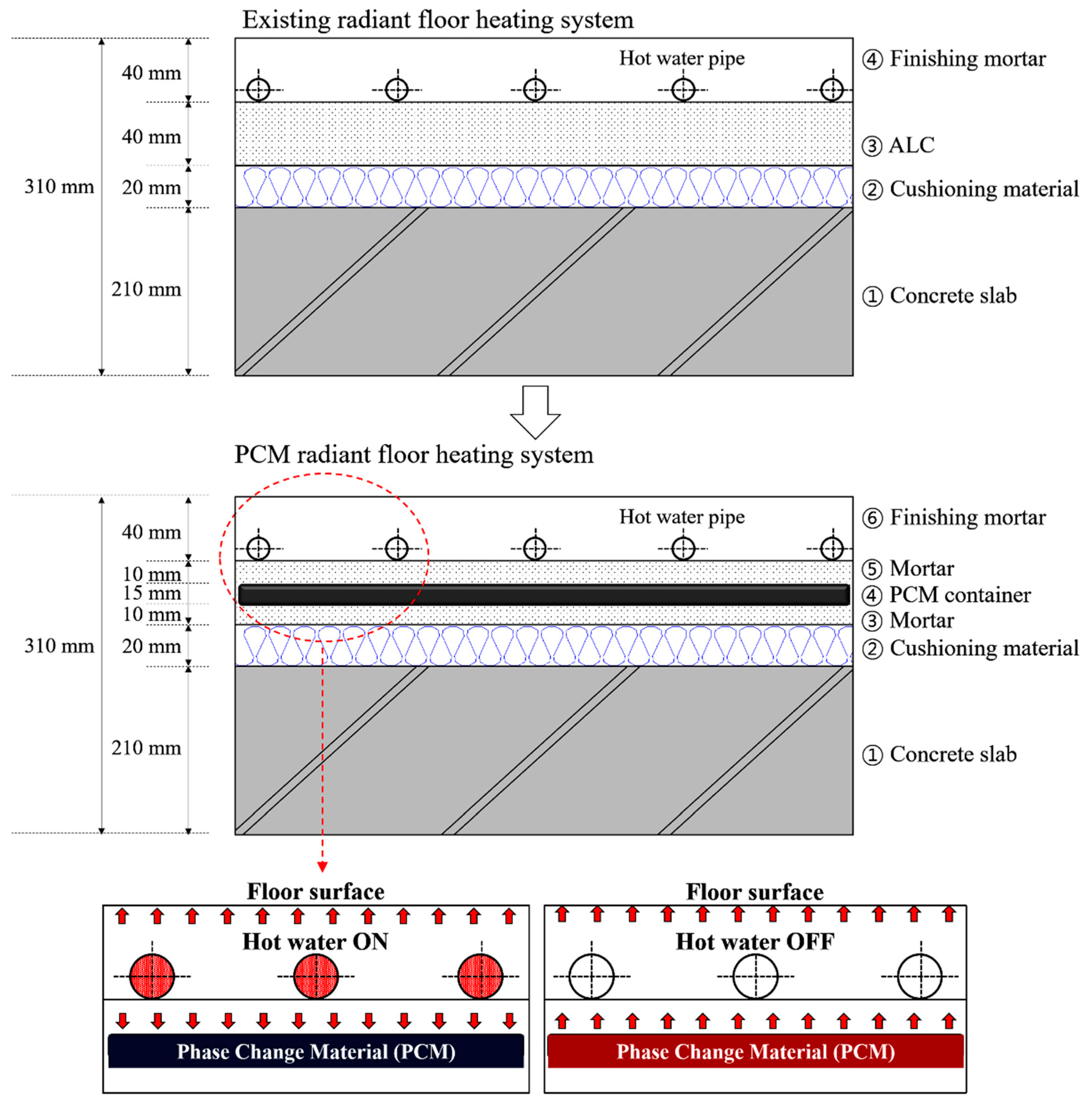
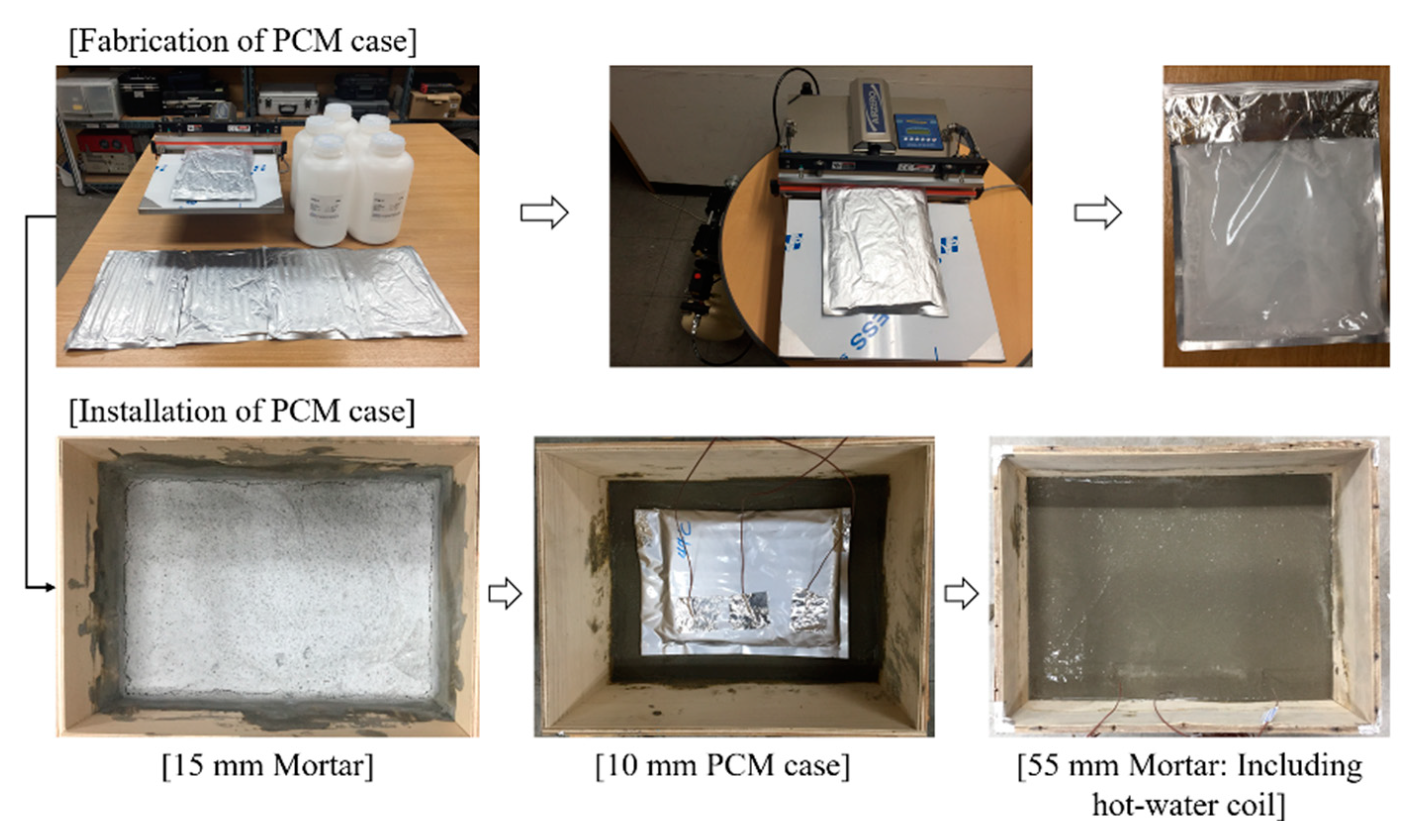

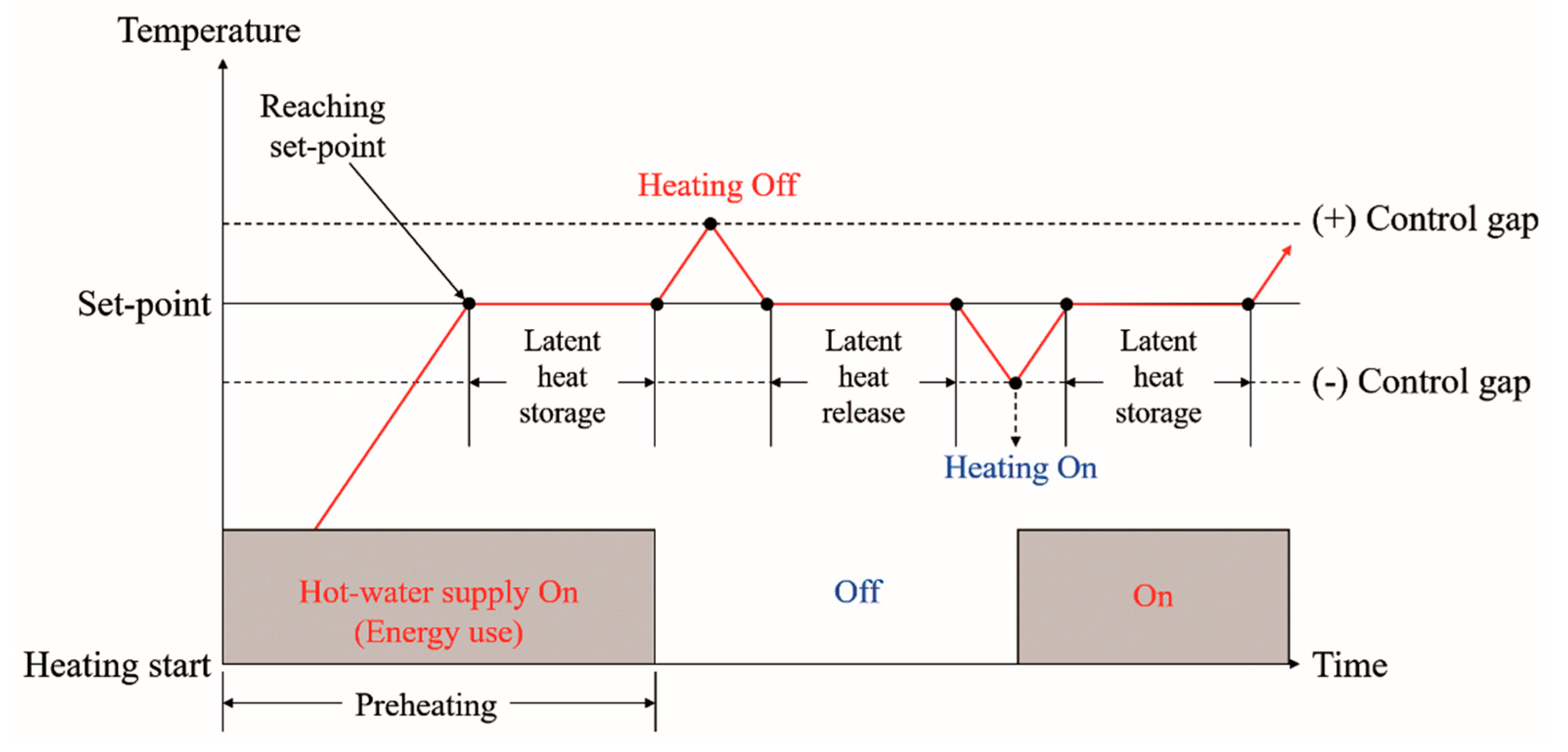


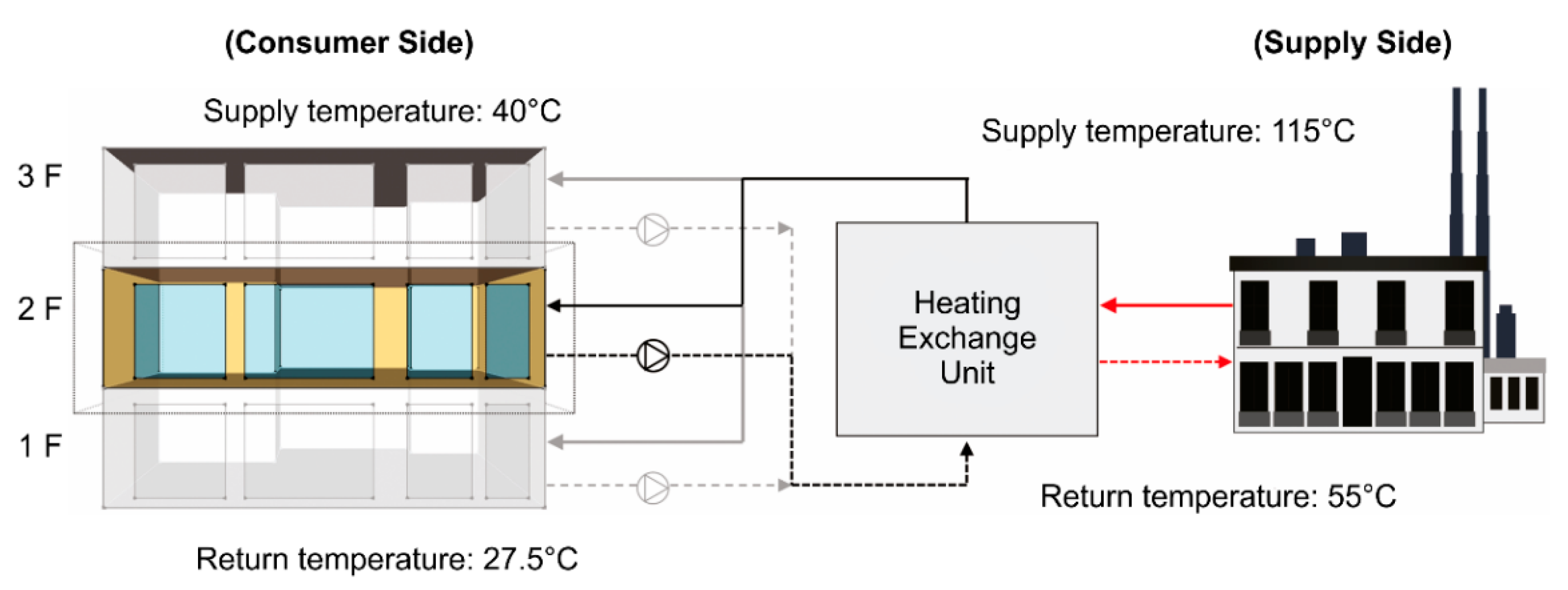
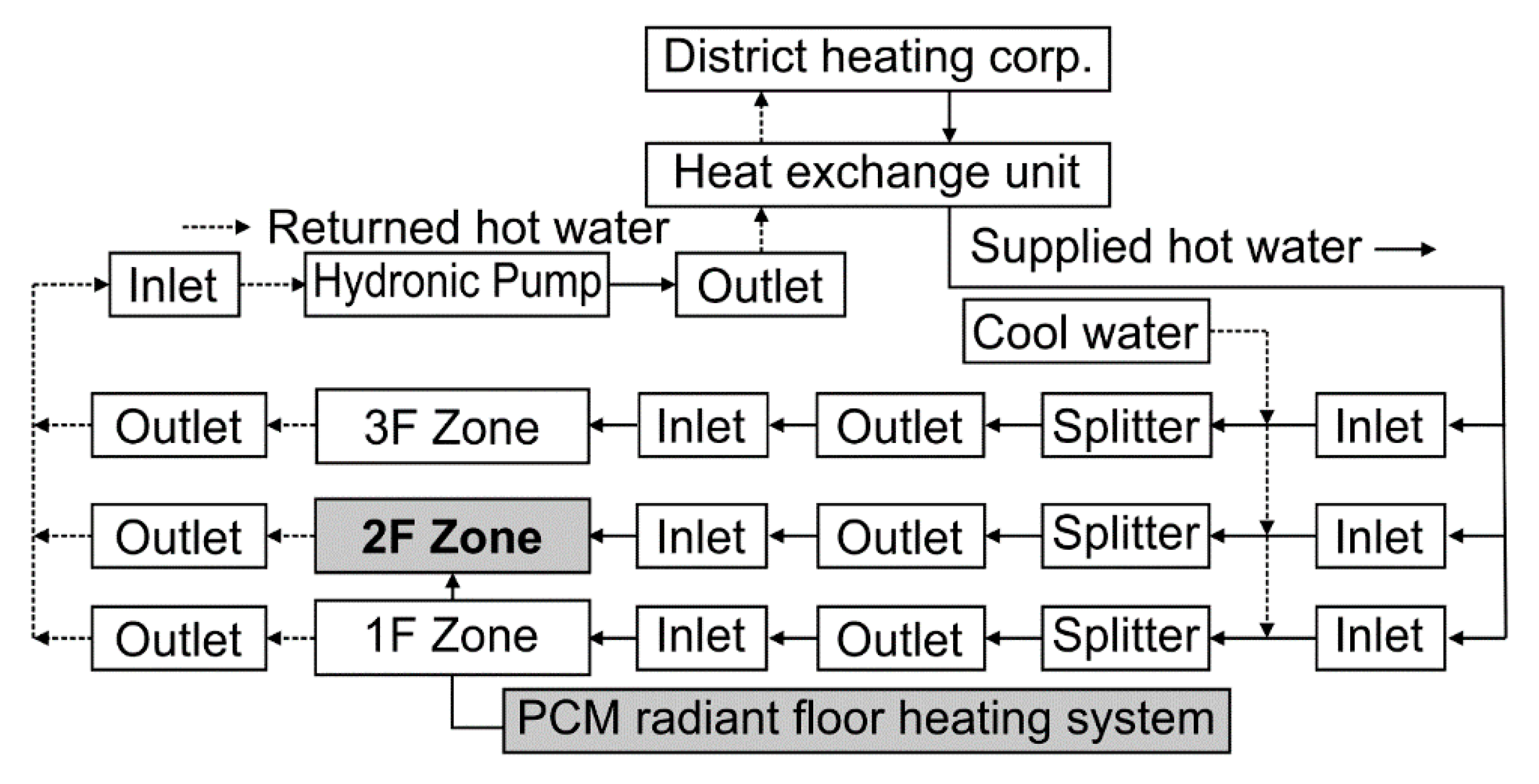
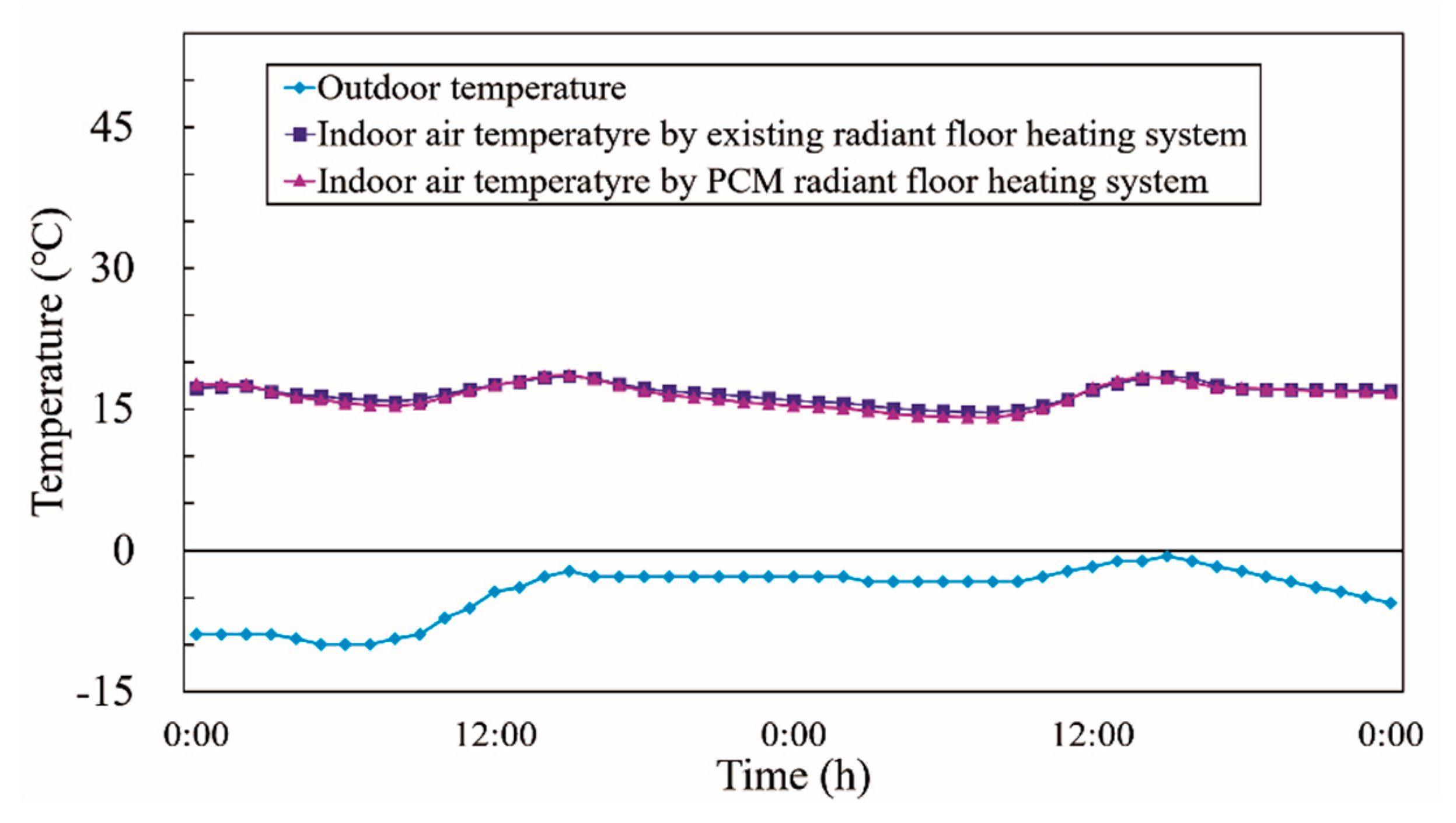

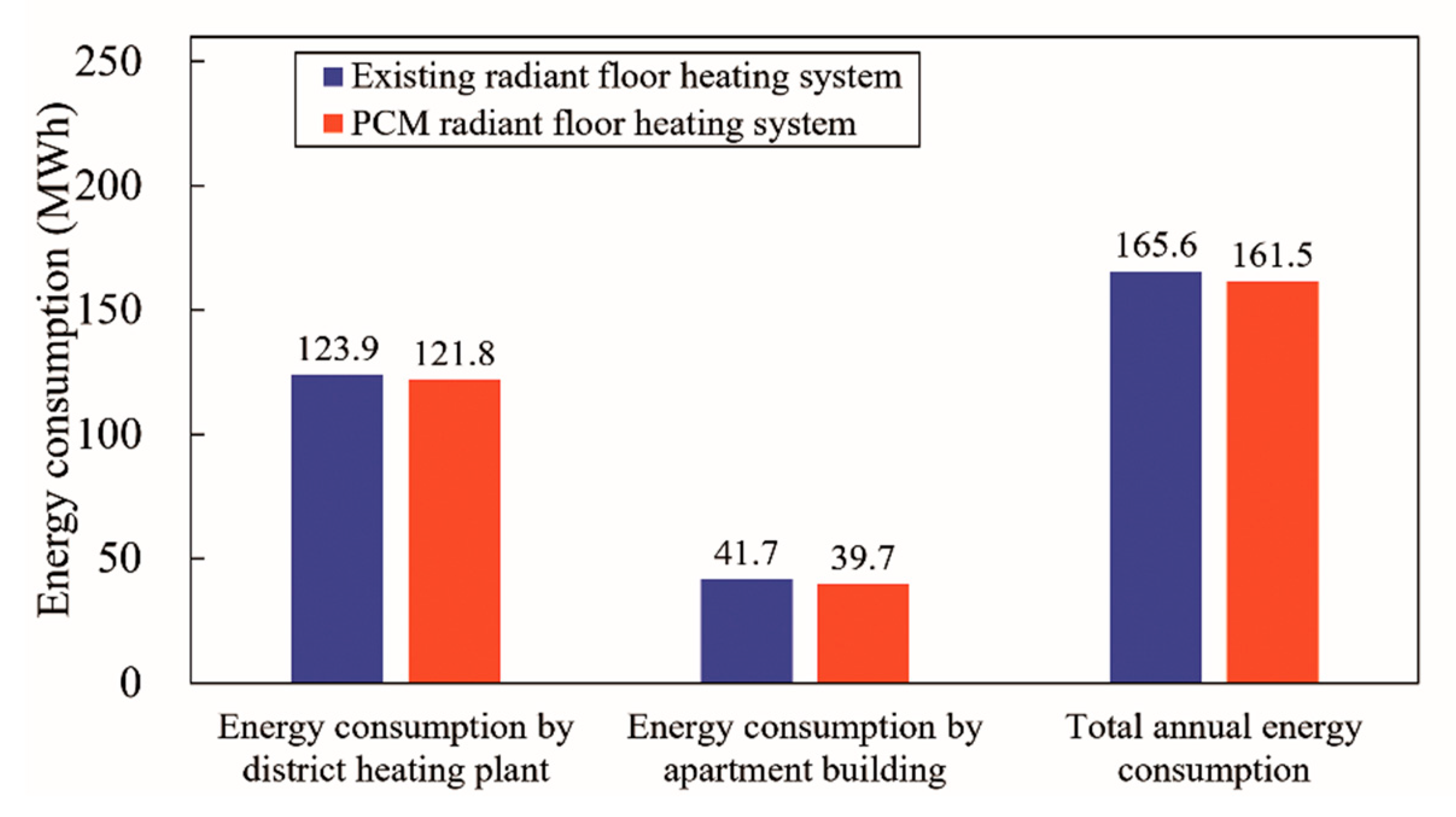



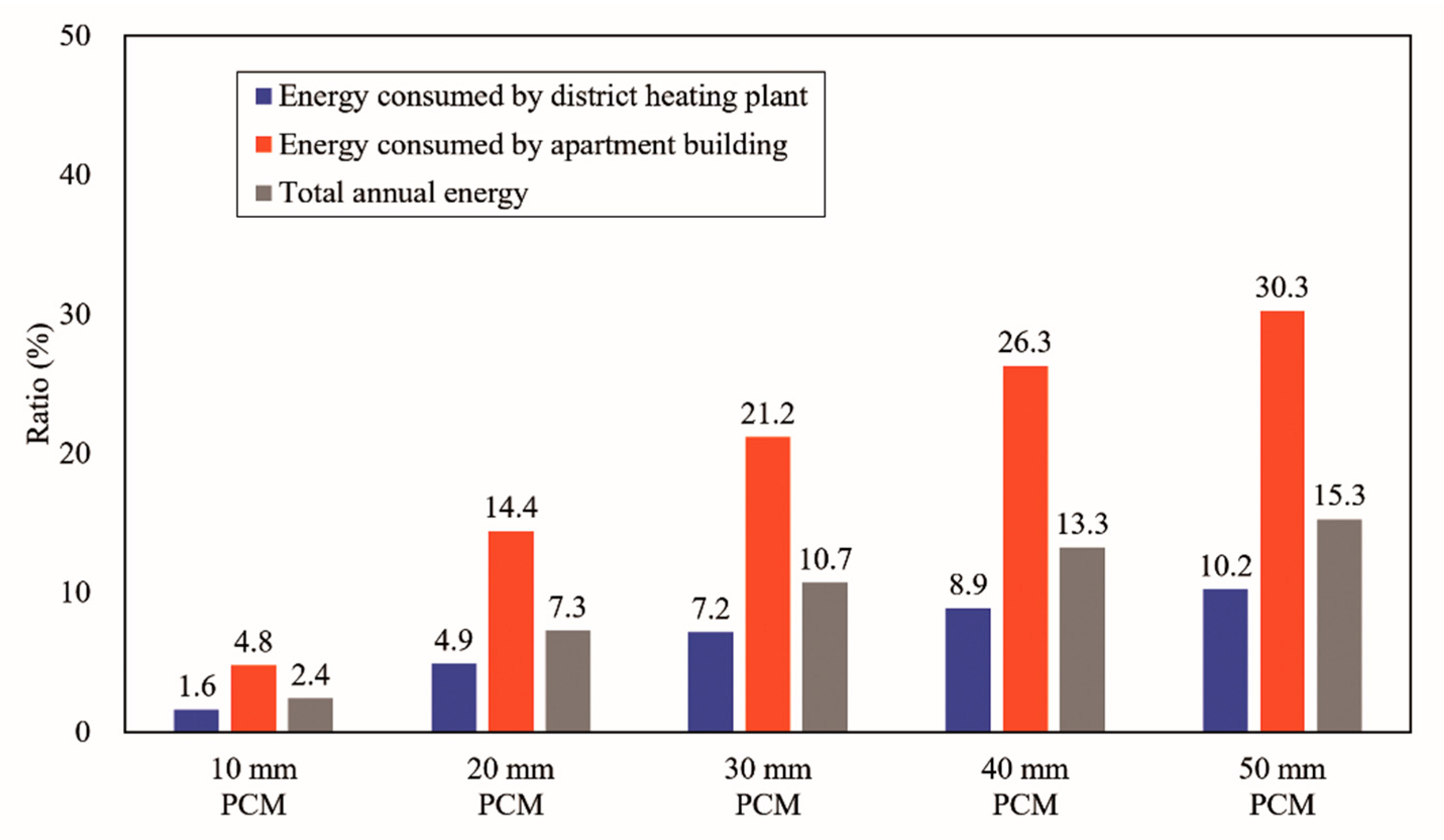
| Author and Company | Year | Type of Floor | Energy Resource | ||
|---|---|---|---|---|---|
| Study | Lin, K. et al. [2] | 2004 | Dry construction | Electrical energy | |
| Lin, K. et al. [3] | 2007 | Dry construction | Electrical energy | ||
| Jin, X. et al. [4] | 2011 | Wet construction | Hot and cold water | ||
| Huang, K. et al. [5] | 2014 | Wet construction | Solar energy & hot water | ||
| Barzin, R. et al. [6] | 2015 | Dry construction | Electrical energy | ||
| Cheng, W. et al. [7] | 2015 | Dry construction | Electrical energy | ||
| Zhou, G. et al. [8] | 2015 | Dry construction | Hot water | ||
| Zhang, Y. et al. [9] | 2016 | Dry construction | Solar energy & hot water | ||
| Plytaria, M. T. et al. [10] | 2018 | Wet construction | Solar energy & hot water | ||
| Company | Negishi corporation Ltd. [11] | Type 1 | 2018 | Dry construction | Solar energy |
| Type 2 | 2018 | Dry construction | Solar energy | ||
| Type 3 | 2018 | Wet construction | Electrical energy | ||
| PCM Type | Melting Point | Specific Heat (Cp) | Density (ρ) | Conductivity (k) |
|---|---|---|---|---|
| (°C) | (J/kg·°C) | (kg/m3) | (W/m·°C) | |
| Organic material | 41–44 | 2000 | 800 | 0.2 |
| Temperature (°C) | Capacity (J/kg) |
|---|---|
| 35 | 2000 |
| 36 | 2000 |
| 37 | 3000 |
| 38 | 2000 |
| 39 | 3000 |
| 40 | 6000 |
| 41 | 43,000 |
| 42 | 53,000 |
| 43 | 107,000 |
| 44 | 25,000 |
| 45 | 2000 |
| 46 | 2000 |
| 47 | 2000 |
| 48 | 2000 |
| 49 | 2000 |
| 50 | 2000 |
| Section | Material | Thickness | U-value (c) | |
|---|---|---|---|---|
| Material | Total | |||
| (mm) | (mm) | (W/m2⋅K) | ||
| 1st-story floor structure | Concrete slab | 210 | 415 | 0.1741 |
| Insulating material | 120 | |||
| ALC | 40 | |||
| Hot-water coil | 15 | |||
| Mortar | 40 | |||
| Finishing material | 5 | |||
| 2nd-story floor structure | Gypsum board | 10 | 425 | 0.1534 |
| Air cavity | 100 | |||
| Concrete slab | 210 | |||
| Insulating material | 20 | |||
| ALC (a) | 15 | |||
| PCM (b) | 10 | |||
| ALC | 15 | |||
| Hot-water coil | 15 | |||
| Mortar | 40 | |||
| Finishing material | 5 | |||
| 3rd-story floor structure | Gypsum board | 10 | 425 | 0.1530 |
| Air cavity | 100 | |||
| Concrete slab | 210 | |||
| Insulating material | 20 | |||
| ALC | 40 | |||
| Hot-water coil | 15 | |||
| Mortar | 40 | |||
| Finishing material | 5 | |||
| 3rd-story roof structure | Gypsum board | 10 | 490 | 0.1105 |
| Air cavity | 100 | |||
| Insulating material | 90 | |||
| Concrete slab | 210 | |||
| Mortar | 80 | |||
| Exterior wall | Concrete wall | 180 | 310 | 0.2005 |
| Insulating material | 120 | |||
| Gypsum board | 10 | |||
| Glass | |||
| Manufacturing company | Shanghai Yaohua Pilkinton Glass Ltd. | ||
| Thickness | 6 (mm) | ||
| Thermal conductivity | 1.000 (W/m⋅K) | ||
| Exterior surface | Total wave | Transmittance | 0.246 |
| Reflectance | 0.232 | ||
| Visible wave | Transmittance | 0.313 | |
| Reflectance | 0.302 | ||
| Surface emissivity | 0.840 | ||
| Interior surface | Total wave | Transmittance | 0.246 |
| Reflectance | 0.218 | ||
| Visible wave | Transmittance | 0.131 | |
| Reflectance | 0.106 | ||
| Surface emissivity | 0.540 | ||
| Insulating gas | |||
| Gas type | Argon (100% pure) | ||
| Thickness | 12 (mm) | ||
| Thermal conductivity | 0.016348 (W/m⋅K) | ||
| Specific heat | 521.929 (J/kg·°C) | ||
| Density | 1.782282 (kg/m3) | ||
| Viscosity | 0.000021 (kg/m·s) | ||
| Prandtl number | 0.6705 | ||
| Triple pane glazing system | |||
| Total thickness | 42 (mm) | ||
| Total U-value | 1.208 (W/m2⋅K) | ||
| Frame system | |||
| Material | Aluminum | ||
| Filled insulating material | Urethane | ||
| Width | 300 (mm) | ||
| Projected length from glazing | 129 (mm) | ||
| Entire window system | |||
| Exterior surface heat transfer coefficient | 23.3 (W/m2⋅K) | ||
| Interior surface heat transfer coefficient | 9.1 (W/m2⋅K) | ||
| Total U-value of window system | 1.208 (W/m2⋅K) | ||
| Factor | Time Interval | Unit | Value |
|---|---|---|---|
| Occupant | 00:00–08:00 | person | 4 |
| 08:00–18:00 | 0 | ||
| 18:00–24:00 | 4 | ||
| Light | 00:00–05:00 | Fraction | 0.1 |
| 05:00–08:00 | 1.0 | ||
| 08:00–18:00 | 0.0 | ||
| 18:00–22:00 | 1.0 | ||
| 22:00–24:00 | 0.1 | ||
| Infiltration | 00:00–24:00 | air-change/h | 3.0 |
| Ventilation | 00:00–08:00 | air-change/h | 0.5 |
| 08:00–18:00 | 0.0 | ||
| 18:00–24:00 | 0.5 |
| Unit | Value | |
|---|---|---|
| Hydronic-pump pipe diameter | 0.015 | (m) |
| Hydronic-pump surface heat loss | Adiabatic | |
| Hydronic-pump flow rate | Autosize | |
| Hydronic-pump head pressure | 200,000 | (Pa) |
| Hydronic-pump motor efficiency | 0.9 | |
| Hydronic-pump control type | Intermittent | |
| Hot-water pipe diameter | 0.015 | (m) |
| Hot-water pipe surface heat loss | Adiabatic | |
| Cool-water pipe diameter | 0.015 | (m) |
| Cool-water pipe surface heat loss | Adiabatic | |
| Splitter flow rate control | Autosize | |
| Factor | Time Interval | Value |
|---|---|---|
| Indoor temperature | 00:00–08:00 | 20 °C |
| 08:00–18:00 | 10 °C | |
| 18:00–00:00 | 20 °C | |
| 18:00-24:00 | 20 °C | |
| Floor surface temperature | 00:00–08:00 | 30 °C |
| 08:00–18:00 | 15 °C | |
| 18:00–00:00 | 30 °C | |
| 18:00-24:00 | 30 °C |
© 2019 by the authors. Licensee MDPI, Basel, Switzerland. This article is an open access article distributed under the terms and conditions of the Creative Commons Attribution (CC BY) license (http://creativecommons.org/licenses/by/4.0/).
Share and Cite
Baek, S.; Kim, S. Analysis of Thermal Performance and Energy Saving Potential by PCM Radiant Floor Heating System based on Wet Construction Method and Hot Water. Energies 2019, 12, 828. https://doi.org/10.3390/en12050828
Baek S, Kim S. Analysis of Thermal Performance and Energy Saving Potential by PCM Radiant Floor Heating System based on Wet Construction Method and Hot Water. Energies. 2019; 12(5):828. https://doi.org/10.3390/en12050828
Chicago/Turabian StyleBaek, Sanghoon, and Sangchul Kim. 2019. "Analysis of Thermal Performance and Energy Saving Potential by PCM Radiant Floor Heating System based on Wet Construction Method and Hot Water" Energies 12, no. 5: 828. https://doi.org/10.3390/en12050828





